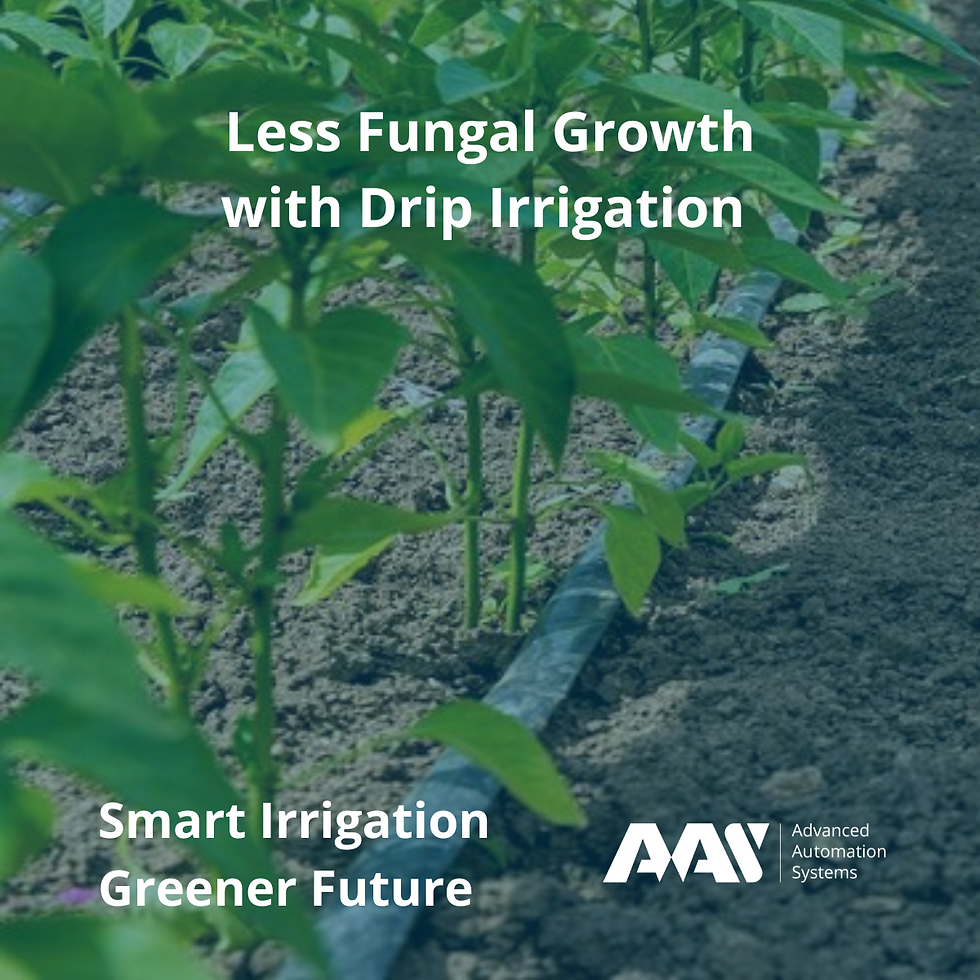Less Fungal Growth with Drip Irrigation
- A.A.S.

- Sep 1
- 3 min read
Drip irrigation drastically reduces fungal growth by minimizing leaf wetness and maintaining optimal soil moisture levels. Since most fungal pathogens (like powdery mildew, botrytis, anthracnose) require free water on plant surfaces or excessively humid conditions to germinate and infect, drip irrigation's targeted application creates an environment that is inherently less hospitable to these diseases.
How Drip Irrigation Minimizes Fungal Growth: The Key Mechanisms
1. Elimination of Leaf Wetness
The Problem with Overhead Irrigation: Sprinklers and other overhead methods douse the entire plant—leaves, stems, flowers, and fruit—in water. This creates the perfect, saturated environment for fungal spores to germinate and penetrate plant tissues.
The Drip Solution: Drip irrigation delivers water slowly and directly to the soil base, keeping the entire canopy of the plant completely dry. This single factor is the most significant contributor to reducing fungal disease pressure.
2. Reduction in Ambient Humidity
How it works: Overhead irrigation evaporates from soil surfaces and plant leaves, significantly raising the relative humidity in the canopy's microclimate. High humidity (>85-90%) is a key trigger for many fungal diseases.
Benefit: By only wetting a small, targeted area of soil, drip irrigation minimizes overall evaporation. This helps keep the air around the plants drier, creating an environment where fungal spores struggle to thrive.
3. Prevention of Soil Splash
The Problem: Rain and overhead sprinklers can cause soil to splash onto lower leaves and fruit. This soil often harbors fungal spores from previous infections.
The Drip Solution: The gentle, localized application of water prevents soil splash, effectively breaking a key cycle of re-infection where soil-borne pathogens are physically transported onto the plant.
4. Optimal Soil Moisture (Avoiding Waterlogging)
How it works: While the primary benefit is a dry canopy, drip also prevents the soil itself from becoming waterlogged.
Benefit: Consistently saturated soil is a breeding ground for certain root rot fungi (like Phytophthora and Pythium). Drip systems can be managed to provide ideal moisture levels for plant roots while avoiding the anaerobic, soggy conditions these pathogens love.
Benefits of Reduced Fungal Disease
Decreased Crop Loss: Less infection directly translates to higher marketable yields and quality.
Reduced Fungicide Use: With a naturally lower disease pressure, farmers can often significantly reduce the number of fungicide applications needed.
Lower Application Costs: This saves money on chemicals and the fuel/labor required to apply them.
Environmental and Health Benefits: Reduced pesticide runoff and residue.
Healthier Plants: Plants not fighting off disease can dedicate more energy to growth and production.
Important Considerations and Best Practices
While drip irrigation is superior for disease management, it is not a magic bullet. Proper management is crucial:
Proper Spacing and Airflow: Drip irrigation reduces humidity, but if plants are overcrowded, natural humidity from transpiration can still create problems. Good spacing and pruning for airflow are still essential.
Weed Management: Weeds can create a humid microclimate at the base of plants. Effective weed control within the rows is necessary to maximize the benefits of drip.
System Maintenance: A leaking coupler or emitter that sprays water onto leaves can create a localized point of disease, negating the system's benefits. Regular system checks are important.
Not a Cure-All for Soil-Borne Disease: Drip irrigation manages moisture to prevent root rot, but if soil is already infested with a pathogen, the disease can still occur. It is a prevention tool, not necessarily a cure.
Watering Schedule: Even with drip, watering in the late afternoon or evening can leave the soil saturated overnight, potentially increasing root zone humidity. Where possible, watering in the early morning is ideal, allowing excess moisture to evaporate during the day.
Comparison with Other Methods
Irrigation Method | Impact on Fungal Growth | Key Reason |
Drip/Trickle | Lowest Risk | Keeps foliage dry, minimizes humidity, no soil splash. |
Sprinkler (Overhead) | Highest Risk | Soaks foliage, dramatically increases humidity, promotes soil splash. |
Furrow/Flood | Moderate-High Risk | Foliage stays dry, but soil splash is high and humidity can rise significantly from wet soil evaporation. |
Conclusion
Drip irrigation is one of the most effective cultural practices for fungal disease management in agriculture. By delivering water directly to the root zone and keeping the plant canopy dry, it removes the essential ingredient that most fungal pathogens need to infect: free water on plant surfaces. This leads to healthier plants, reduced reliance on fungicides, higher yields, and a more sustainable growing system.
Smart Irrigation Greener Future




Comments